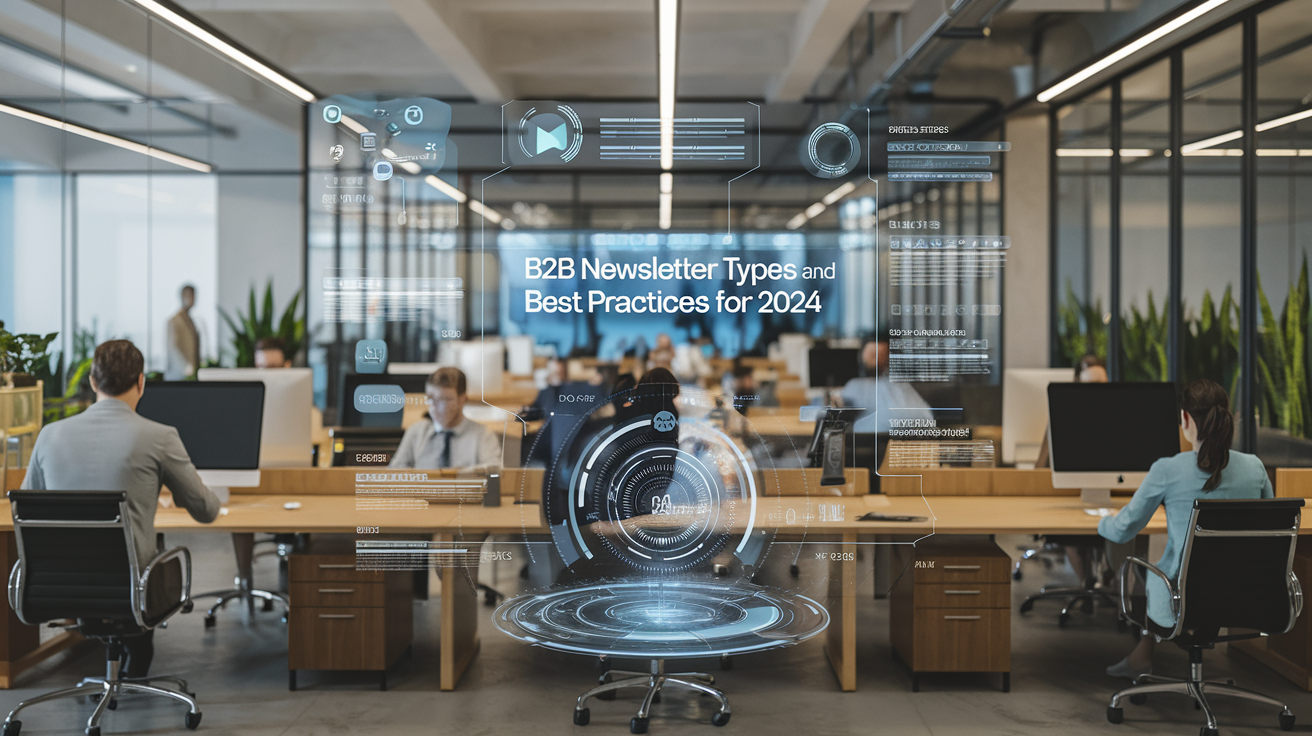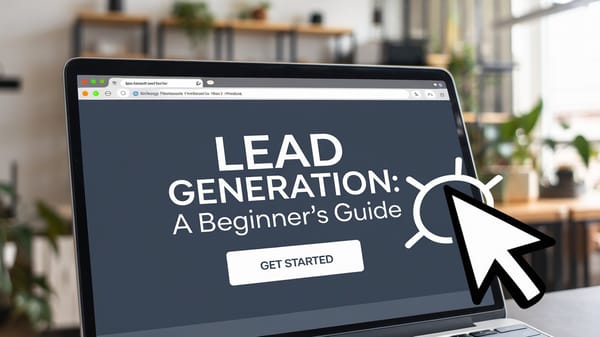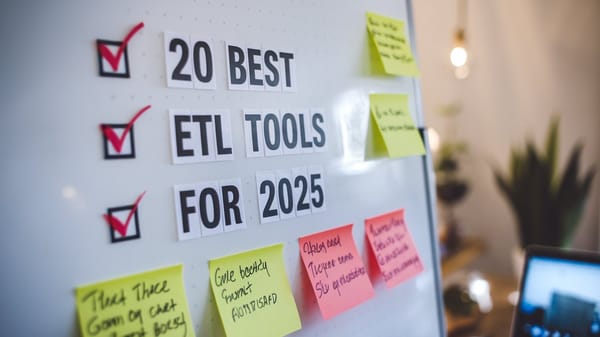B2B Newsletter Types and Best Practices for 2024

As we navigate through 2024, the significance of newsletters in B2B communication continues to grow, driven by advancements in technology and changing consumer expectations. This report delves into the most effective types of B2B newsletters and the best practices that businesses should adopt to stay ahead in this competitive arena.
The success of B2B newsletters in 2024 hinges on several key trends. Intriguing subject lines, personalization, data-driven content, and mobile-friendly design are at the forefront of these trends. The integration of versatile AI technologies further enhances the ability to deliver personalized and relevant content to each recipient, thereby increasing engagement and conversion rates.
Moreover, the rise of interactive newsletters is transforming the way businesses communicate with their audience. Incorporating elements such as quizzes, real-time polls, and interactive graphics not only captures attention but also encourages active participation. These interactive features can significantly boost click rates and drive sales, making them a valuable addition to any B2B newsletter strategy.
Consistency in newsletter delivery is another crucial factor in building trust and maintaining audience engagement. Regularly scheduled newsletters help establish expectations and foster a sense of reliability among recipients. Additionally, the design and functionality of newsletters play a critical role in their effectiveness. A well-designed newsletter template should be visually appealing, easy to navigate, and responsive across devices, ensuring a seamless experience for all users.
As businesses strive to create high-quality newsletters, it is essential to continuously test and optimize their content. A/B testing and metric analysis, such as open rates and click-through rates, provide valuable insights into what resonates with the audience and what needs improvement. By leveraging these insights, businesses can refine their strategies and enhance the overall impact of their newsletters.
You can also visit Oncely.com to find more Top Trending AI Tools. Oncely partners with software developers and companies to present exclusive deals on their products. One unique aspect of Oncely is its “Lifetime Access” feature, where customers can purchase a product once and gain ongoing access to it without any recurring fees. Oncely also provides a 60-day money-back guarantee on most purchases, allowing customers to try out the products and services risk-free.
Oncely are hunting for the most fantastic AI & Software lifetime deals like the ones below or their alternatives:

Table of Contents
- B2B Newsletter Trends and Best Practices for 2024
- Personalization and AI Integration
- Interactive Content
- Mobile-Friendly Design
- Data-Driven Content
- Consistency and Brand Alignment
- Conclusion
- Personalization and AI in B2B Newsletters
- Leveraging AI for Enhanced Personalization
- AI-Powered Personalization Techniques
- The Role of First-Party Data
- AI and Personalization: A Strategic Imperative
- Best Practices for AI-Driven Personalization
- Design and Interactive Elements in B2B Newsletters
- Interactive Elements in B2B Newsletters
- Design Principles for B2B Newsletters
- Mobile-Friendly Design
- Personalization and AI Integration
- Consistency and Brand Alignment
B2B Newsletter Trends and Best Practices for 2024
Personalization and AI Integration
In 2024, personalization remains a cornerstone of effective B2B newsletters. The ability to tailor content to individual recipients based on their preferences, behaviors, and past interactions is no longer a luxury but a necessity. This approach enhances engagement, as personalized newsletters have been shown to significantly improve open rates, click-through rates, and conversions (Penfriend).
The integration of AI further amplifies personalization capabilities. AI tools can analyze vast amounts of data to predict user preferences and automate content customization. This not only saves time but also ensures that each recipient receives content that is most relevant to them. The synergy between AI and personalization is a "match made in heaven," driving deeper connections with audiences (Penfriend).
Interactive Content
Interactive newsletters are gaining traction as a powerful tool to boost engagement. By incorporating elements such as quizzes, real-time polls, and interactive graphics, businesses can transform passive reading into an engaging experience. These features not only increase click rates but also enhance the overall user experience, making newsletters more memorable and impactful (Penfriend).
Interactive elements can be as simple as embedded surveys or as complex as gamified experiences like scratch-card rewards or spin-the-wheel discounts. While these strategies are traditionally associated with B2C marketing, they can be innovatively adapted for B2B contexts to drive engagement and foster a sense of community among recipients (Penfriend).
Mobile-Friendly Design
With the increasing reliance on mobile devices for email consumption, ensuring that newsletters are mobile-friendly is crucial. A mobile-optimized design not only improves readability but also enhances user experience, leading to higher engagement rates. In 2024, B2B newsletters must prioritize responsive design to cater to the growing number of mobile users (Penfriend).
Mobile-friendly newsletters should feature concise content, clear calls-to-action (CTAs), and visually appealing layouts that adapt seamlessly to different screen sizes. This approach not only aligns with user preferences but also helps businesses stay competitive in a crowded digital landscape (Penfriend).
Data-Driven Content
Data-driven content is another key trend shaping B2B newsletters in 2024. By leveraging analytics and insights, businesses can create content that resonates with their audience and addresses their specific needs and interests. This approach not only enhances the relevance of newsletters but also positions businesses as thought leaders in their respective industries (Penfriend).
To effectively implement data-driven strategies, businesses should regularly analyze metrics such as open rates, click rates, and conversion rates. This data can provide valuable insights into what content is working and what needs improvement, allowing businesses to continuously refine their newsletter strategies for optimal results (Penfriend).
Consistency and Brand Alignment
Consistency in messaging and design is essential for building trust and maintaining audience engagement. B2B newsletters should align with the overall brand identity, ensuring that every communication reinforces the brand's values and messaging. Inconsistencies can confuse readers and dilute the impact of the brand, making it crucial to maintain a cohesive and recognizable design across all newsletters (Penfriend).
Moreover, consistent delivery schedules help set expectations and build anticipation among recipients. By establishing a regular cadence, businesses can foster a sense of reliability and trust, encouraging recipients to engage with newsletters consistently (Penfriend).
Conclusion
The landscape of B2B newsletters in 2024 is characterized by a focus on personalization, interactivity, mobile optimization, data-driven content, and consistency. By embracing these trends and best practices, businesses can create newsletters that not only capture attention but also drive meaningful engagement and conversions. As the digital marketing landscape continues to evolve, staying ahead of these trends will be crucial for businesses looking to maintain a competitive edge in the B2B space.
Personalization and AI in B2B Newsletters
Leveraging AI for Enhanced Personalization
In the evolving landscape of B2B newsletters, personalization has emerged as a critical factor for success. The integration of Artificial Intelligence (AI) into personalization strategies is not just a trend but a necessity for staying competitive. AI enables marketers to analyze vast amounts of data, providing insights that allow for more targeted and relevant content delivery. According to ON24, nearly 90% of B2B marketers plan to use AI for personalization, underscoring its importance in the current marketing ecosystem.
AI-driven personalization allows for the segmentation of audiences based on various parameters such as past interactions, engagement data, and buyer personas. This segmentation leads to more effective targeting and messaging, as evidenced by a B2B software company that saw a 25% increase in email open rates and a 30% increase in click-through rates after implementing AI-powered personalization (ON24).
AI-Powered Personalization Techniques
AI facilitates several personalization techniques that enhance the effectiveness of B2B newsletters. One such technique is the use of generative AI to create personalized content at scale. This approach allows marketers to tailor content based on a prospect’s previous interactions, industry, or specific pain points, thereby increasing engagement and conversion rates (ON24).
Another technique involves personalizing offers and calls-to-action within existing content. For instance, personalized webinar invites can significantly boost attendance and engagement. By incorporating personalized recommendations and follow-up actions based on attendee behavior during webinars, marketers can enhance the overall user experience (ON24).
The Role of First-Party Data
First-party data plays a crucial role in AI-driven personalization. Despite its importance, many B2B marketers do not strategically use this asset to its full potential. According to ON24, only 30% of marketers personalize by buying stage, and even fewer personalize based on content-level or account-level engagement history.
To maximize the benefits of first-party data, marketers should focus on improving data quality, quantity, and structure. This involves ensuring that data is collected, accurate, structured, and consistently mapped across platforms and tools. By doing so, marketers can achieve better results from both AI-powered and traditional technology solutions (ON24).
AI and Personalization: A Strategic Imperative
The integration of AI and personalization in B2B newsletters is not just about enhancing engagement but also about meeting the expectations of modern buyers. According to Forrester research, two-thirds of B2B buyers expect the same level of personalization in their professional lives as they do in their personal lives (ON24).
AI helps marketers identify patterns and preferences in customer behavior that might not be immediately apparent. This deeper level of personalization allows for more relevant and timely content delivery, which is crucial for maintaining customer interest and driving conversions (ON24).
Best Practices for AI-Driven Personalization
To effectively implement AI-driven personalization in B2B newsletters, marketers should adhere to several best practices. First, they should leverage AI to analyze engagement data and past interactions, enabling more effective audience segmentation and messaging. Second, marketers should focus on personalizing existing content, such as offers and calls-to-action, to enhance user engagement without extensive rework (ON24).
Additionally, marketers should prioritize the use of first-party data, ensuring that it is collected, accurate, and structured consistently across platforms. This will enable more effective personalization and better results from AI-powered solutions (ON24).
In conclusion, the integration of AI and personalization in B2B newsletters is a strategic imperative for 2024. By leveraging AI to deliver personalized content at scale, marketers can enhance engagement, conversion rates, and overall business outcomes. As the digital marketing landscape continues to evolve, embracing AI-driven personalization will be key to staying competitive and meeting the expectations of modern buyers.
Design and Interactive Elements in B2B Newsletters
Interactive Elements in B2B Newsletters
In 2024, the effectiveness of B2B newsletters is significantly enhanced by incorporating interactive elements. These elements transform newsletters from passive reading experiences into engaging platforms that encourage reader participation. Interactive features such as quizzes, real-time polls, and surveys are becoming increasingly popular. They not only increase engagement but also provide valuable insights into audience preferences and behaviors (Penfriend AI).
Interactive elements can range from simple embedded surveys to more complex features like animated graphics or gamified experiences such as scratch-card styled rewards or spin-the-wheel discounts. While these techniques are traditionally associated with B2C marketing, they can be innovatively adapted for B2B purposes to drive engagement and increase click-through rates (Penfriend AI).
Design Principles for B2B Newsletters
The design of a B2B newsletter is crucial in capturing and retaining the audience's attention. A well-designed newsletter should be visually appealing, functional, and adaptable. The design should align with the brand's overall identity to avoid confusion and maintain brand consistency (Penfriend AI).
A successful newsletter design template is not solely about aesthetics; it must also be practical. This includes ensuring ease of use, accessibility, and responsive design to cater to a diverse audience accessing content on various devices. The adaptability of the design allows for customization to meet specific business needs and audience preferences (Penfriend AI).
Mobile-Friendly Design
With the increasing use of mobile devices for accessing content, a mobile-friendly design is no longer optional but essential for B2B newsletters. Ensuring that newsletters are easily readable and navigable on mobile devices can significantly enhance user experience and engagement. This involves using responsive design techniques that automatically adjust the layout and content to fit different screen sizes (Penfriend AI).
Mobile-friendly designs should also consider the loading speed of newsletters on mobile devices. Optimizing images and minimizing the use of heavy graphics can improve loading times, ensuring that readers do not abandon the newsletter due to slow performance. This is particularly important as mobile users tend to have shorter attention spans and higher expectations for quick access to information (Penfriend AI).
Personalization and AI Integration
Personalization is a key trend in B2B newsletters for 2024, and AI plays a crucial role in enhancing this aspect. By leveraging AI, businesses can deliver highly personalized content that resonates with individual readers. This involves using data-driven insights to tailor content based on reader preferences, behaviors, and past interactions (Penfriend AI).
AI-powered personalization techniques include dynamic content insertion, where different content is displayed to different users based on their profiles. This can significantly increase engagement and conversion rates as readers receive content that is relevant to their interests and needs. Additionally, AI can help in segmenting audiences more effectively, allowing for more targeted and personalized communication (Penfriend AI).
Consistency and Brand Alignment
Maintaining consistency in design and content is vital for reinforcing brand identity and building trust with the audience. Inconsistencies in design can confuse readers and dilute the impact of the brand message. Therefore, it is important to ensure that the newsletter design aligns with the overall brand design and messaging strategy (Penfriend AI).
Consistency also extends to the frequency and timing of newsletter distribution. Regularly scheduled newsletters help in establishing a routine and setting expectations with the audience. This can lead to higher open rates and engagement as readers anticipate receiving valuable content at predictable intervals (Be Omniscient).
In conclusion, the design and interactive elements of B2B newsletters in 2024 are pivotal in enhancing audience engagement and achieving business goals. By incorporating interactive features, ensuring mobile-friendly design, leveraging AI for personalization, and maintaining consistency, businesses can create effective newsletters that resonate with their target audience and drive desired outcomes.
References
- https://penfriend.ai/blog/b2b-newsletter-design
- https://www.waveon.io/en/blog/best-b2b-marketing-newsletters-for-industry-insights-and-trends
- https://revopsteam.com/marketing/best-b2b-newsletters/
- https://beomniscient.com/blog/b2b-newsletters/
- https://thecmo.com/career-development/best-b2b-newsletters/





